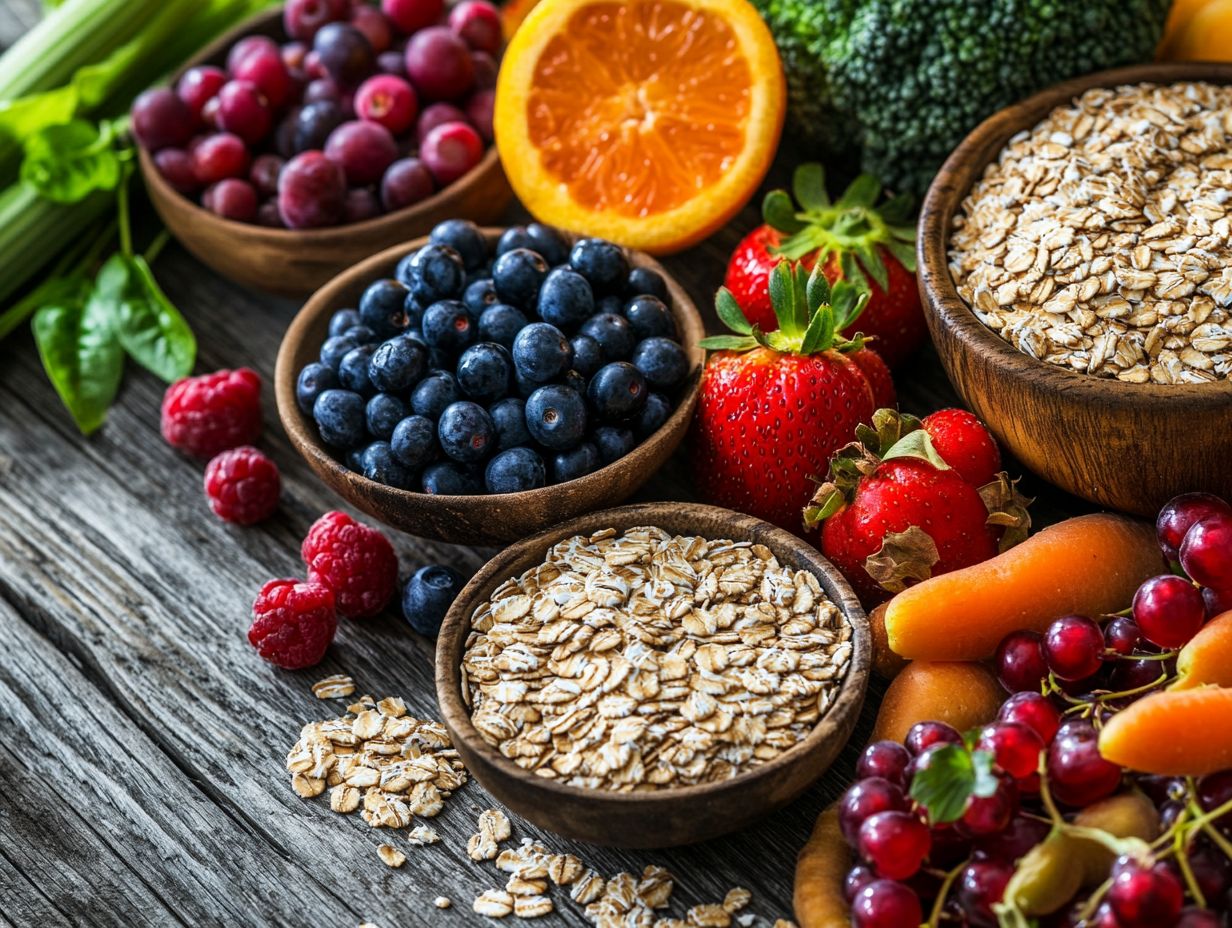The Role of Fiber in Dietary Guidelines
Fiber is an essential component of a balanced diet, often underestimated despite its remarkable health benefits.
From boosting digestion to lowering the risk of chronic diseases, understanding fiber can truly revolutionize your eating habits. This article explores the nature of fiber, the recommended daily intake, and the countless advantages a high-fiber diet can offer.
You’ll also find practical tips for incorporating more fiber-rich foods into your meals, along with a discussion on the potential downsides of excessive intake. By the end, you ll be ready to transform your health!
Contents
Key Takeaways:

Fiber is an essential nutrient found in plant-based foods and supplements. It plays a crucial role in digestion and overall health. The current dietary guidelines also emphasize understanding fats in dietary guidelines, recommending a daily intake of 25-38 grams of fiber for adults, but most people do not meet this recommendation.
Increasing fiber intake can have numerous benefits, including improved digestion, weight management, and reduced risk of chronic diseases.
Understanding Fiber in the Diet
Understanding fiber in your diet is important for your health.
Dietary fiber, primarily sourced from fruits, vegetables, whole grains, and legumes, falls into two main categories: soluble and insoluble fiber. Soluble fiber dissolves in water, while insoluble fiber does not. Both types offer a range of health benefits, including better movement in your digestive system, enhanced metabolic health, and a reduced risk of chronic diseases such as cardiovascular issues and colon cancer.
Following dietary recommendations for fiber intake can greatly boost your digestive health and elevate your overall well-being.
What is Fiber?
Fiber is an essential element of a healthy diet, divided into two primary categories: soluble and insoluble fiber, each providing distinct health advantages.
Soluble fiber dissolves in water to form a gel-like substance. It plays a crucial role in lowering cholesterol levels and stabilizing blood sugar, making it particularly beneficial for those managing diabetes or focusing on heart health. You ll find soluble fiber in foods like:
- Oats
- Barley
- Apples
- Beans
These nutritious options are also quite versatile in the kitchen.
In contrast, insoluble fiber does not dissolve in water but is vital for promoting digestive health. It adds bulk to stool and helps ensure regular bowel movements. Excellent sources of insoluble fiber include:
- Whole grains
- Nuts
- Vegetables such as carrots and broccoli
All of which support gut function and help reduce the risk of constipation.
By incorporating a balanced intake of both types of fiber into your diet, you can pave the way for improved health outcomes and a greater sense of well-being.
Recommended Daily Intake of Fiber
The recommended daily intake of fiber can vary based on factors such as age, gender, and individual health needs. However, general guidelines indicate that adults should aim for approximately 25 to 38 grams of dietary fiber each day to promote optimal health.
This advice is supported by reputable sources like the U.S. Department of Agriculture and the American Heart Association.
Current Dietary Guidelines
Current dietary guidelines underscore the significance of sufficient fiber intake within a balanced diet, while also addressing the role of supplements in dietary guidelines and highlighting their myriad health benefits.
Aim for at least 25 to 30 grams of fiber daily, primarily sourced from whole foods. Embrace a colorful array of fruits, vegetables, whole grains, legumes, and nuts, as these are excellent contributors to your fiber goals.
Research shows that following these recommendations can markedly lower your risk of chronic diseases such as heart disease, diabetes, and certain types of cancer, while enhancing digestive health.
By weaving a variety of fiber-rich foods into your daily meals, you not only elevate your overall well-being but also bolster gut health, promoting improved digestion and regular bowel movements.
The Benefits of a High-Fiber Diet

Adopting a high-fiber diet presents a wealth of health benefits that are hard to ignore. You’ll notice improvements in your digestive health, enhanced gut motility, and a lowered risk of chronic conditions like cardiovascular disease and diabetes.
This eating way not only helps maintain a healthy weight but also helps regulate blood sugar levels and promotes a sense of fullness.
By integrating fiber-rich foods into your meals, you can elevate your overall well-being and pave the way for a longer, healthier life.
Improved Digestion and Health
Dietary fiber enhances gut motility and minimizes the risk of conditions such as constipation and diverticular disease. Beyond its role in helping you go to the bathroom regularly, dietary fiber is crucial for preventing more serious issues, like colon cancer.
By adding bulk to the stool, it ensures that your digestive tract operates efficiently, reducing the likelihood of blockages and inflammation. Incorporating fiber-rich foods think beans, whole grains, and fruits like apples and berries, along with vegetables such as broccoli and carrots should be a staple in your daily meals.
You can easily boost your fiber intake by adding these foods to your breakfast and snacks. Perhaps opt for oatmeal topped with fresh fruit or indulge in whole grain toast adorned with avocado.
These small yet impactful changes can significantly enhance both your digestive health and overall well-being.
Sources of Fiber
You ll find a wealth of fiber in a variety of food categories, such as vibrant fruits and vegetables, hearty whole grains, and nutritious legumes and beans. These sources not only offer essential nutrients but also play a crucial role in supporting a healthy diet.
Plant-Based Foods and Supplements
Plant-based foods, such as whole grains, legumes, and beans, are exceptional sources of dietary fiber. While fiber supplements can certainly assist you in meeting your daily fiber requirements, it’s fascinating to know that incorporating a variety of these foods into your daily meals can greatly enhance your overall health.
They promote digestive wellness and help you feel full. When you opt for fiber-rich options, you’re not just reaping the benefits of natural vitamins and minerals; you’re also sidestepping the isolated effects often linked to supplements.
Try adding chia seeds, lentils, and oats to your meals they’re great choices known for their high fiber content and can significantly contribute to achieving your recommended daily intake.
If you find it challenging to consume enough plant-based foods, a fiber supplement might serve as a practical solution, helping to bridge the gap while still encouraging healthier dietary habits.
Incorporating Fiber into Meals
Adding fiber to your meals is essential, and it’s easier than you think! You can accomplish this through straightforward strategies that elevate your fiber intake across diverse food groups.
Tips for Increasing Fiber Intake

To effectively increase your fiber intake, you can easily incorporate a few simple tips that seamlessly fit into a high-fiber diet.
By choosing whole grain options like brown rice or whole wheat bread, you can significantly elevate your daily fiber consumption. Adding legumes such as lentils and beans to your salads or soups not only enhances the texture but also delivers a hearty dose of fiber along with essential proteins.
Snacking on a variety of fruits and vegetables, like apples, carrots, or berries, can also help you reach your fiber goals. These foods are not just rich in fiber; they re also packed with vitamins and antioxidants that promote overall health.
For instance, a cup of cooked lentils contains about 15.6 grams of fiber, making it an excellent choice to meet your dietary recommendations while enjoying delicious meals.
Potential Risks of Too Much Fiber
While fiber is essential for good health, too much of it can lead to problems. It’s important to balance your intake to enjoy the benefits without negative effects.
Side Effects and Precautions
Excessive fiber intake can negatively impact your digestive health. Symptoms like bloating, gas, and constipation may turn mealtime into an uncomfortable experience.
Increase your fiber intake gradually. This gives your digestive system time to adjust.
Stay hydrated! Drinking enough fluids helps move fiber through your intestines.
By balancing fiber and hydration, you can enjoy the benefits without unwelcome side effects. These steps lead to improved digestive health and overall well-being.
Frequently Asked Questions
What is the recommended daily intake of fiber according to dietary guidelines?
Women should aim for 25 grams of fiber daily, while men should aim for 38 grams. This may vary based on age, gender, and health status.
Why is fiber important in our diet?

Fiber helps you poop regularly and prevents constipation. It also lowers cholesterol and controls blood sugar, reducing risks of heart disease and diabetes.
What are the main sources of fiber in our diet?
Fiber is found in plant foods like fruits, vegetables, whole grains, and legumes. High-fiber options include apples, broccoli, whole wheat bread, and lentils.
How does fiber contribute to weight management?
Fiber-rich foods are filling, helping you stay satisfied longer and reducing overeating. These foods are usually lower in calories, making them great for weight loss.
Can I consume too much fiber?
Yes, too much fiber can cause bloating, gas, and diarrhea. Increase your fiber intake gradually to avoid discomfort.
What are some tips to increase fiber intake in my diet?
Incorporate more fruits and vegetables into your meals. Choose whole grain options and snack on high-fiber foods like nuts and seeds. Read food labels and pick products with higher fiber content.






